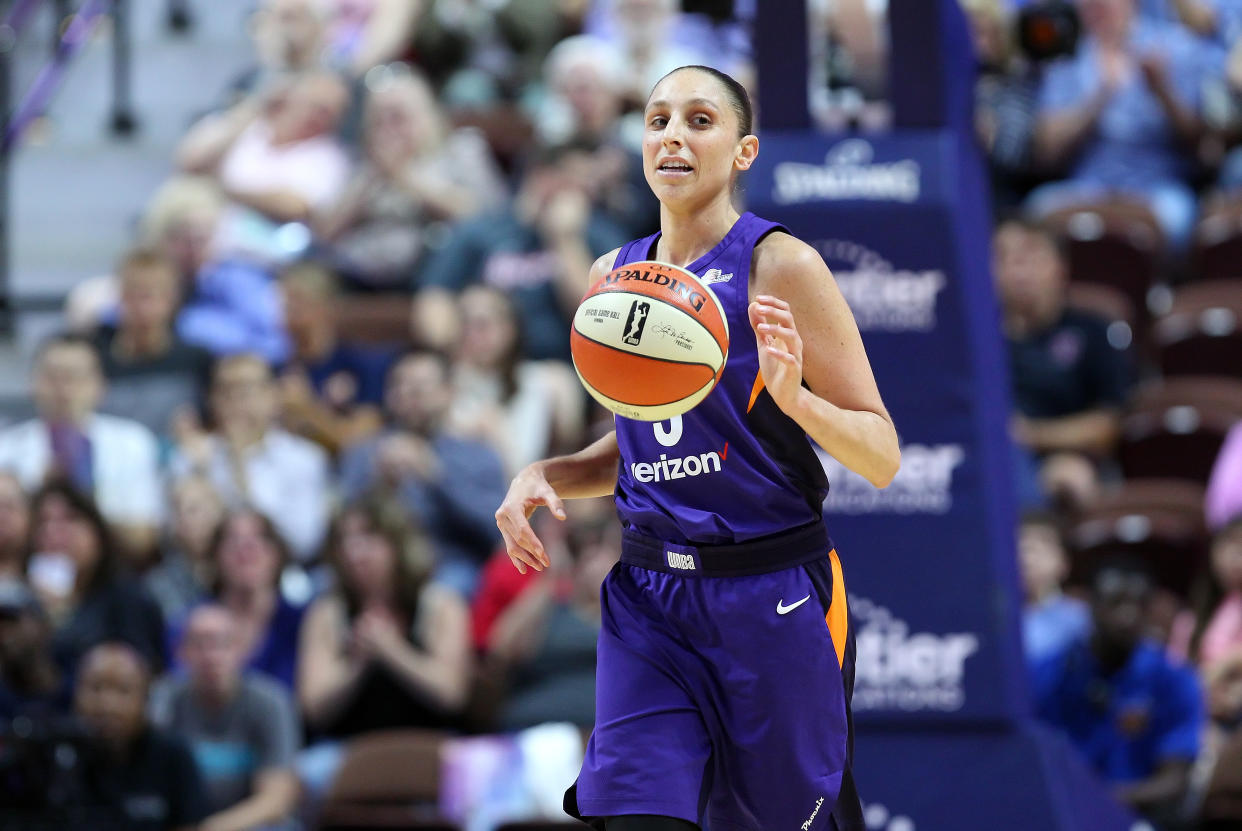Diana Taurasi: WNBA players have to 'go to a communist country to get paid like capitalists'

Phoenix Mercury superstar Diana Taurasi is making a splashy entrance to the WNBA’s All-Star weekend. The 16-year veteran and three-time WNBA champion held little back in a Q&A with ESPN’s Josh Weinfuss, taking aim at the lightning rod pay issue, an inability to follow NBA’s marketing leadership and the NFL not giving “two s---s about player safety.”
Taurasi: pay scale doesn’t make sense
The lightning rod issue in the WNBA — not unlike other women’s teams — is pay and it will be a key factor in negotiations for the Collective Bargaining Agreement (CBA).
The rookie minimum is $41,965 in base salary, a number Taurasi said is less than what a janitor at the arena would make. It’s unfair, she said, given that players such as the Mercury’s Brittney Griner are asked to “carry the league” when they come in.
As with many WNBA stars, Taurasi plays overseas in the league’s offseason to offset her $117,500 base max salary and makes around $1.5 million from her Russian team.
We had to go to a communist country to get paid like capitalists, which is so backward to everything that was in the history books in sixth grade. And even then, even within our pay scale, it doesn't make sense. On a team, you could have seven players making the same amount of money. That doesn't make sense to me.
Players are seeking a larger cut of the revenue in the next CBA, which is very different than the commonly used notion they want “equal pay” to NBA players’ salaries. They do model their league after the NBA, which has left Taurasi “disillusioned” with how the league can’t find its way, she told ESPN.
And it's just shocking to me, as we have the NBA as the best model ever. But the WNBA always finds a way to mess it up.
Taurasi remarks on leaving job with small raises
One quote in particular should send a shudder down WNBA executives spines and it’s a reaction that’s been raised by other players. Taurasi estimates over the last 11 years, salaries have increased a total 1.5 percent.
“I mean, who doesn’t leave that job?” she told ESPN.
Taurasi sat out the 2015 WNBA season upon request by her club, UMMC Ekaterinburg, so that she could rest instead of play year-round. More superstars may follow, a notion raised again when reigning MVP Breanna Stewart ruptured her Achilles.
Women’s basketball stars want to play in their home country, in front of fans who have watched their collegiate careers up close. It’s not unlike any other professional athlete. But bigger pay-days overseas might force them to drop the WNBA schedule.
Taurasi: Leagues ‘lying’ when they say they care about players
One of the issues in players taking part in basketball year round is first a larger chance of injuries and second an inability to reset their bodies between grueling seasons. Taurasi took direct aim at a league insisting they want their players rested and in good shape without providing for it, whether by money or perks. And she brought the NFL into the fray by name as well.
Any league that talks about that — they care about their players — is lying. Like I had to watch [NFL commissioner] Roger Goodell talk about player safety. He doesn't give two s---s about player safety.
NFL players are also working on a new CBA, which expires after the 2020 season, and the schedule could become a large part of it. The league and owners are always after new income and are currently eyeing a longer 18-game regular season schedule. The NFLPA opposed the idea a decade ago on the grounds of player safety.
Marketing a big part of inequality
Marketing has evolved over the years, but in a world that has more choice than ever it has only gained in importance. It’s impossible to talk about inequality in women’s sports without mentioning the lack of marketing compared to counterparts.
The WNBA Players Association opted out of its CBA in part for better marketing, something seen in the national women’s hockey team’s boycott before hosting the world championships and the USWNT soccer squad’s lawsuit against its federation.
The league introduced a brand “refresh” prior to the season with a new logo and color scheme, but what players have been asking for for years is what the NBA shines at: showcasing its players and their personalities.
Once again, I just don't understand how the NBA has made rock stars out of their best players ... if you think about what they've been able to do marketing-wise. And obviously it started with Magic and Larry and Isiah, and then obviously Jordan took it to the next level. And then you had Kobe, Shaq, and now you have LeBron, Harden, Steph, Durant.
They've made rock stars out of these players. And we just have not been able to capitalize on any of that. Not even a little bit. Not even one bit. Like, are you kidding me with some of the stuff that they do marketing and promoting-wise? It's almost mind-boggling.
Washington Mystics forward Elena Delle Donne, a team captain for the weekend’s All-Star game, spoke about it last July. She told the Philadelphia Inquirer the league needs to be more visible and ensure people know about players, big games, TV stations and even when the league runs.
More from Yahoo Sports:


